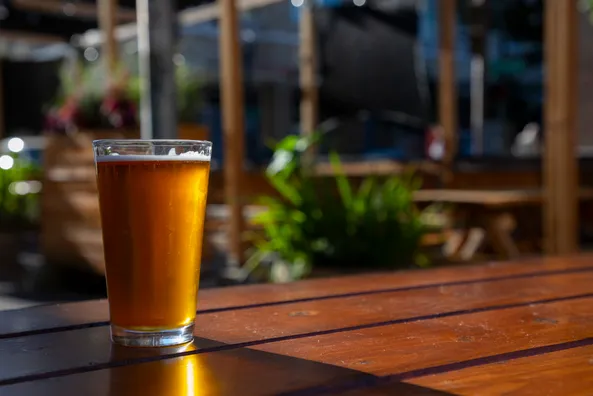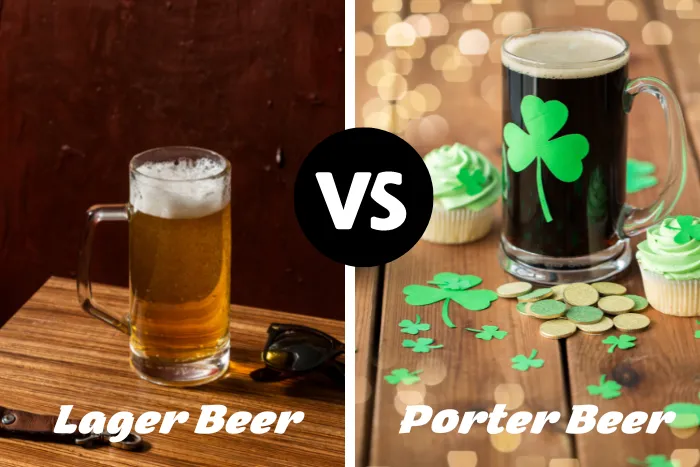From light lagers to dark porters, beer has been around for centuries and is enjoyed by many. But what exactly are the differences between these two popular styles of beer? In this blog post, we will be exploring “lager vs. porter” in terms of history, brewing process, taste and color profiles, alcohol content levels as well as calorie count.
We will also discuss some famous examples from around the world so you can choose which one suits your preferences best! Get ready to learn about lager versus porter – let’s dive in!
Table of Contents:
- History of Lager and Porter Beers
- Brewing Process for Lager and Porter Beers
- Taste, Color, Alcohol Content, and Calorie Content of Lager and Porter Beers
- Popular Examples of Lagers and Porters Around the World
- Conclusion: Comparing the Characteristics of Different Types of Beer
- FAQs in Relation to Lager vs Porter
- Conclusion
History of Lager and Porter Beers

Origin of Larger Beer
Lager beer is a type of bottom-fermented beer that originated in Germany during the 16th century. It was developed by Bavarian brewers who used cool temperatures and slow fermentation to produce a light, crisp, and refreshing beverage. Lagers are typically brewed with pale malts and noble hops, which give them their characteristic flavor profile.
Origin of Porter Beer
Porter beer is an English dark ale style that has existed since the 18th century. It was initially created as a blend of several different ales for use in pubs throughout London. Porters are usually made from roasted barley or malt, giving them deep color and a robust flavor profile. They also tend to have higher alcohol content than lagers due to their longer fermentation process.
From their humble beginnings, lager and porter beers have evolved into popular styles of beer enjoyed by many. Now let’s explore the brewing process for these two distinct beer types.
Brewing Process for Lager and Porter Beers
Lager and porter beers are two of the most popular beer styles in the world. While they share some similarities, there are distinct differences between them when it comes to their brewing processes. In this article, we’ll explore the ingredients used in each type of beer and any unique techniques or methods employed in their production.
Ingredients Used in Lager Beer Brewing:
Lagers typically use a combination of barley malt, hops, yeast, and water. The malted barley is usually lightly kilned to create a light-colored base for the beer. Hops provide bitterness and aroma, while yeast helps with fermentation.
Water plays an important role, too; different types of water can produce different flavors depending on their mineral content and pH level. Some lagers may also include adjuncts such as corn or rice which can add sweetness or body to the finished product.
Ingredients Used in Porters Beer Brewing:
Porters are darker than lagers because they use darker roasted malts. Chocolate malt and other specialty grains like black patent malt add flavor complexity, dark coloration, and coffee notes to the nose and palate.
Porters are less bitter than pale ales and IPAs due to their higher alcohol by volume, so hops are used at lower levels than lagers (ABV). Fermentation requires yeast, but unlike lagers, which use one strain throughout the brewing process, porters use multiple strains at different stages to achieve more complex flavors before bottling the final product for end-user customers who enjoy these flavorful craft brews.
Brewing lager and porter beers can be complex, but understanding their differences is critical to creating the perfect beer. Now let’s look at how their taste, color, alcohol, and calorie content differ.
Taste Differences Between Lager and Porter Beers:

The taste of lager beer is generally light, crisp, and refreshing. It has a mild hop flavor with notes of maltiness. On the other hand, porter beers have a more complex flavor profile with roasted malts that give them a dark chocolate or coffee-like character.
Color Differences Between Lager and Porter Beers:
Lagers are usually pale yellow to golden, while porters range from deep brown to black.
Alcohol Content in Lager and Porter Beers:
Alcohol Content Differences Between Lager and Porter Beers: Lagers tend to be lower in alcohol content than porters, ranging from 4% ABV to 8% ABV or higher, depending on the style.
Calorie Content in Lager and Porter Beers:
When it comes to calorie content, lagers tend to be lighter than porters due to their lower alcohol content as well as their lighter body. A 12-ounce serving of an average lager will contain around 150 calories, whereas a 12-ounce serving of an average porter will contain around 200 calories or more, depending on its strength.
The taste, color, alcohol, and calorie content of lager and porter beers can vary significantly depending on the type. Now let’s look at some famous examples of lagers and porters worldwide.
Popular Examples of German-Style Lagers Around the World
German-style lagers are characterized by their light, crisp taste and low-hop bitterness.
Some famous examples include
- Helles, a pale golden lager with a malty flavor;
- Pilsner, a light golden beer that is slightly hoppy and has an herbal aroma
- Munich Dunkel, a dark brown lager with roasted malt flavors
- Marzenbier, an amber-colored beer with sweet toasted malt notes
- Bockbier which is vital in alcohol content but mild in flavor
FAQs in Relation to Lager vs Porter
Is a porter a lager?
No, a porter is not a lager. A porter is a dark-colored beer made with roasted malt and hops that originated in England in the 18th century. It has a fuller body and higher alcohol content than most lagers.
Lagers are bottom-fermented beers that are light to medium bodied with lower alcohol content and milder hop flavor than ales or porters. They also have cleaner flavors due to their longer fermentation process at cooler temperatures.
Is porter a strong beer?
Porter is a dark beer with a robust flavor and aroma. It is usually brewed with roasted malts, which give it its characteristic dark color and spicy taste. The strength of a porter can vary depending on the ingredients used in brewing.
Still, porters are generally considered medium-bodied beers with an ABV (alcohol by volume) ranging from 4% to 6%. They have more complex flavors than lighter beers like lagers or pale ales.
What kind of beer is a porter?
Porter is a dark beer that originated in London, England, in the 18th century. It is made with roasted malts and hops, giving it a robust flavor profile with notes of coffee, chocolate, caramel, and toffee.
Porter typically has an ABV (alcohol by volume) between 4-6%, making it slightly more robust than most other beers. Depending on the recipe used, its color ranges from deep brown to almost black. Porters are often enjoyed as an after-dinner drink or for special occasions due to their complex flavor profile and higher alcohol content.
What are the 4 types of beers?
- Lagers: These are the most common type of beer, characterized by a light and crisp flavor profile. They are fermented at cooler temperatures for longer periods of time, resulting in a smoother taste with less bitterness than other beers.
- Ales: Ales have a fuller body and more complex flavor than lagers due to their higher fermentation temperature and shorter aging period. Common styles include pale ales, IPAs, stouts, porters, wheat beers and Belgian-style ales.
- Hybrid Beers: Hybrid beers combine characteristics from lager and ale styles to create unique flavors that don’t fit into either category alone. Examples include cream ales, kölschs, and steamed beers.
- Specialty Beers: Specialty beers are those that use unusual ingredients or brewing techniques to produce unique flavors not found in traditional beer styles, such as fruit-flavored sours or barrel-aged imperial stouts aged in whiskey barrels for months or even years before being released for sale.
Conclusion
In conclusion, lager and porter beers are two of the most popular types of beer around the world. They have different histories, brewing processes, ingredients, tastes, colors, alcohol contents, and calorie counts. While both can be enjoyed for their unique characteristics and flavors, it is essential to understand their differences to make an informed decision when choosing a beer. Whether you prefer a light lager or a dark porter beer – understanding the nuances between these two styles will help you find your perfect pint!
Are you a beer enthusiast looking to find the best lagers and porters? Do you want to learn more about craft brewing, equipment reviews, or subscription services for your favorite brews? Look no further! Brew Publik is here with all of the answers. Our blog covers everything from in-depth beer reviews to how-to guides on making your homebrew. With our comprehensive content library, we’ll help ensure that every pint is as perfect as possible – so get ready for a fantastic experience in the world of lager vs. porter!
Also See: The Best Nutmeg Beer: Top 10
